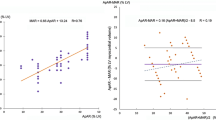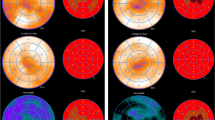Abstract
Background
This study aimed to verify whether the assessment of defect severity and the infusion of nitrates during tracer injection improve the capability of data-based 99mTc-labeled sestamibi single-photon emission computed tomography (SPECT) to recognize hibernating myocardium.
Methods and Results
Of 66 asynergic coronary territories in 40 patients with left ventricular dysfunction, 28 had postrevascularization functional recovery (hibernating) and 38 had unchanged dysfunction (fibrotic). Defect severity was lower in the hibernating than in the fibrotic territories on both baseline (p<0.01) and nitrate SPECT (p<0.002). Nitrate was superior to baseline SPECT to differentiate the hibernating from the fibrotic territories (sensitivity 96% vs 75%, p<0.05; receiver-operating characteristic curve area 0.75 vs 0.63, p<0.001) and to identify the patients with improved left ventricular ejection fraction (receiver-operating characteristic curve area 0.68 vs 0.58; p<0.05).
Conclusions
The analysis of defect severity in combination with nitrate infusion clearly improves the value of 99mTc-labeled sestamibi SPECT for the recognition, of hibernating myocardium and the prediction of postrevascularization recovery.
Similar content being viewed by others
References
DuPuey EG, Garcia EV. Optimal specificity of thallium-201 SPECT through recognition of imaging artifacts. J Nucl Med 1989;31:441–9.
Chua T, Kiat H, Germano G, et al. Rapid back to back adenosine stress/rest technetium-99m teboroxime myocardial perfusion SPECT using a triple-detector camera. J Nucl Med 1993;34:1485–93.
Germano G, Chua T, Kiat H, Areeda JS, Berman DS. A quantitative phantom analysis of artifacts due to hepatic activity in technetium-99m myocardial perfusion SPECT studies. J Nucl Med 1994;35:356–9.
Nowak DJ. How liver activity reduces reconstructed SPECT heart activity. Eur J Nucl Med 1994;21:S64.
Nuyts J, Dupont P, Van den Maegdenbergh V, Vleugels S, Suetens P, Mortelmans L. A study of liver-heart artifact in emission tomography. J Nucl Med 1995;36:133–9.
Manglos SH, Jaszczak RJ, Floyd CE, Hahn LJ, Greer KL, Coleman RE. Nonisotropic attenuation in SPECT: phantom tests of quantitative effects and compensation techniques. J Nucl Med 1987;28:1584–91.
Manglos SH, Jaszczak RJ, Floyd CE, Hahn LJ, Greer KL, Coleman RE. A quantitative comparison of attenuation-weighted backprojection with multiplicative and iterative postprocessing attenuation compensation in SPECT. IEEE Trans Med Imag 1988;7:128–34.
Glick SJ, King MA, Knesaurek K, Burbank K. An investigation of the stationarity of the three-dimensional modulation, transfer function of SPECT. IEEE Trans Nucl Sci 1989;36:973–7.
Glick SJ, Hawkins WG, King MA, Penney BC, Soares EJ, Byrne C. Choice of intrinsic attenuation correction method and the three-dimensional modulation transfer function of SPECT. Med Phys 1992;19:1105–12.
Knesaurek K, King MA, Glick SJ, Penney BC. Investigation of the causes of geometrical distortion in 180° and 360° angular sampling SPECT. J Nucl Med 1989;30:1666–75.
O'Connor MK, Kelly BJ. Evaluation of techniques for the elimination of “hot” bladder artifacts in SPECT of the pelvis. J Nucl Med 1990;31:1872–75.
Gillen GJ, Gilmore, B, Elliott AT. An investigation of the magnitude and causes of count loss artifacts in SPECT imaging. J Nucl Med 1991;32:1771–6.
Tsui BMW, Zhao XD, Gregoriou GK et al. Quantitative cardiac SPECT reconstruction with reduced image degradation due to patient anatomy. IEEE Trans Nucl Sci 1994;41:2838–48.
Ljungberg M, Strand S-E. A Monte Carlo program for the simulation of scintillation camera characteristics. Comp Meth Prog Biomed 1989;29:257–72.
Garica EV, Cooke CD Van Train KF, et al. Technical aspects of myocardial SPECT imaging with technetium-99m sestamibi. Am J Cardiol 1990;66:29E-31E.
Garcia EV, Van Train K, Maddahi J et al. Quantification of rotational thallium-201 myocardial tomography J Nucl Med 1985;26:17–26.
Zhao XD, Tsui BMW, Gregoriou GK, Lalush DS, Li J, Eisner RL. Evaluation of corrective reconstruction methods using a three-dimensional cardiac-torso phantom and bull's-eye plots. IEEE Trans Nucl Sci 1995;41:2831–7.
LaCroix KL, Tsui BMW, Hasegawa BH. Comparison of 180 and 360 iterative reconstruction with non-uniform attenuation compensation for Tl-201 SPECT. IEEE Trans Nucl Sci 1995;42:1276–81.
Galt JR, Garcia EV, Robbins WL. Effects of myocardial wall thickness on SPECT quantification. IEEE Trans Med Imag 1990;9:144–50.
Bartlett ML, Bacharach SL, Voipio-Pulkki L-M, Dilsizian V. Artifactual inhomogeneities in myocardial PET and SPECT scans in normal subjects. J Nucl Med 1995;36:188–95.
Ljungberg M, King MA, Hademenous GJ, Strand SV. Comparison of four scatter correction methods using Monte Carlo simulated source distributions. J Nucl Med 1994;35:143–51.
Tsui BMW, Gullberg GT, Edgerton ER, et al. Correction of nonuniform attenuation in cardiac SPECT imaging. J Nucl Med 1989;30:497–507.
Galt JR, Cullom SJ, Garcia EV. SPECT Quantification: a simplified method of attenuation and scatter correction for cardiac imaging. J Nucl Med 1992;33:2232–7.
Glick SJ, Penney BC, King MA, Byrne CL. Noniterative compensation for the distance-dependent detector response and photon attenuation in SPECT imaging. IEEE Trans Med Imag 1994;13:363–74.
Zeng GL, Gullberg GT, Tsui BMW, Terry JA. Three-dimensional iterative reconstruction algorithms with attenuation and geometric point response correction. IEEE Trans Nucl Sci 1991;38:693–702.
Lee J, Chae SC, Lee K, Heo J, Iskandrian AS. Biokinetics of thallium-201 in normal subjects: comparison between adenosine, dipyridamole, dobutamine and exercise. J Nucl Med 1994;35:535–41.
Hademenous GJ, King MA, Ljungberg M, Zubal G, Harrell CR. A scatter correction method for Tl-201 images: a Monte Carlo investigation. IEEE Trans Nucl Sci 1993;30:1179–86.
Author information
Authors and Affiliations
Rights and permissions
About this article
Cite this article
Sciagrà, R., Bisi, G., Santoro, G.M. et al. Influence of the assessment of defect severity and intravenous nitrate administration during tracer injection on the detection of viable hibernating myocardium with data-based quantitative technetium 99m-labeled sestamibi single-photon emission computed tomography. J Nucl Cardiol 3, 221–230 (1996). https://doi.org/10.1016/S1071-3581(96)90036-7
Received:
Accepted:
Issue Date:
DOI: https://doi.org/10.1016/S1071-3581(96)90036-7




